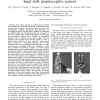Free Online Productivity Tools
i2Speak
i2Symbol
i2OCR
iTex2Img
iWeb2Print
iWeb2Shot
i2Type
iPdf2Split
iPdf2Merge
i2Bopomofo
i2Arabic
i2Style
i2Image
i2PDF
iLatex2Rtf
Sci2ools
ICRA
2003
IEEE
2003
IEEE
Experimental analysis of an innovative prosthetic hand with proprioceptive sensors
— This paper presents an underactuated artificial hand intended for functional replacement of the natural hand in upper limb amputees. The natural hand has three basic functionalities: grasping, manipulation and exploration. To accomplish the goal of restoring these capabilities by implanting an artificial hand, two fundamental steps are necessary: to develop an artificial hand equipped with artificial proprioceptive and exteroceptive sensors and to fabricate an appropriate interface able to exchange sensory-motor signals with the amputee’s body and the central nervous system. In order to address these objectives, we have studied an underactuated hand according to a biomimetic approach, and we have exploited robotic and microengineering technologies to design and fabricate its building blocks. The architecture of the hand comprises the following modules: an actuator system embedded in the underactuated mechanical structure (artificial muscoskeletal system), a proprioceptive se...
| Added | 04 Jul 2010 |
| Updated | 04 Jul 2010 |
| Type | Conference |
| Year | 2003 |
| Where | ICRA |
| Authors | Maria Chiara Carrozza, Fabrizio Vecchi, F. Sebastiani, Giovanni Cappiello, Stefano Roccella, Massimiliano Zecca, Roberto Lazzarini, Paolo Dario |
Comments (0)

